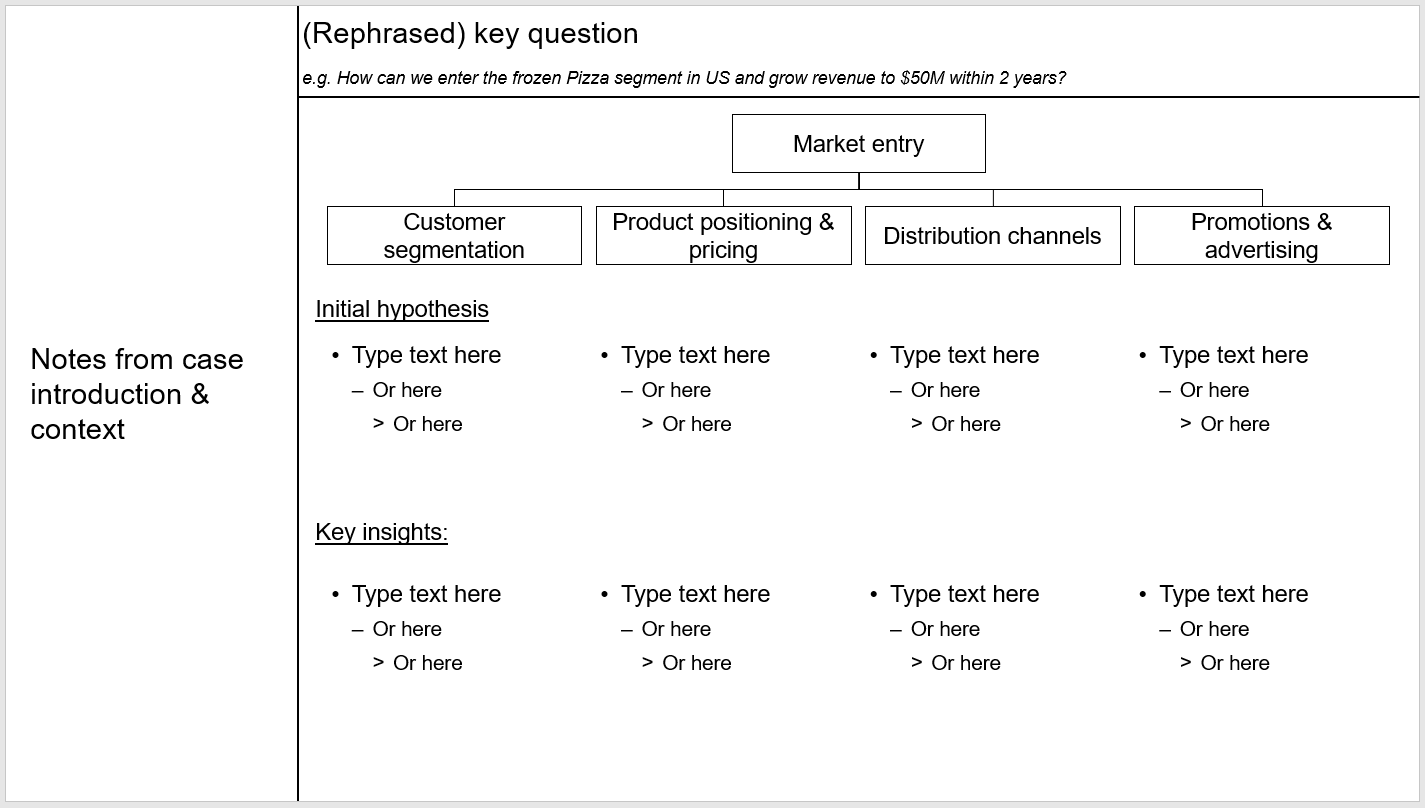My notetaking is poor. I often get lost in my numbers and have trouble getting all the pieces of information in the initial section. What are the best notetaking guides that you have seen?
Get Active in Our Amazing Community of Over 451,000 Peers!
Links to be best notetaking resources?
Overview of answers
Hi,
Several things here:
- If you don't have enough time, it is always fine to ask the interviewer in a polite manner to repeat what he just said. Basically, you have no choice.
- Another way is to increase the speed of taking the notes. Use acronyms, and practice to write short descriptions.
- Make a recap - usually, I recommend making a recap after asking clarifying questions, but in your case, it may be beneficial to make a recap right in the beginning. "Do I Understand correctly that..."
There are some questions that you should always try to ask in addition to what he told you:
1) You can also ask the interviewer to tell you more about the business model and how the company generates money. Even if you think you understand it, try to repeat it to make sure that you understand it correctly. e.g. if the case is about oil&gas company which revenues are declining, ask if it is Up / mid / down-stream problem. In this case, defining a revenue stream is critical to setting up the right structure.
2) Clarify the objective. Here make sure that your goal is:
- Measurable
- Has a time-framed
- Has / has no limitations
e.g. Should I invest 100k in this business for 1 year if I want to get 15% return?
Note-taking tips:
Split the main sheet into 2 parts and then the left part into 2 quadrants:
- Upper left - initial information given at the beginning of the interview and while asking clarifying questions
- Lower left - Your objective. The objective should be measurable and should have a timeline
- Right part - Your structure and the whole case flow
Also, a good practice is to put the key numbers near the corresponding buckets.
! Have a separate sheet for math calculations !
Best!
Hi Anonymous,
in order to write better notes, my recommendation is to divide the paper into 4 areas as reported below for the first page; when taking notes, you can then put the information in the appropriate box. Sometimes you would have to go back and forth, as you may get information, objective 1, additional information, objective 2, etc.
- top-left: who is the client
- bottom left: initial information
- top right: objectives
- bottom right: structure
The vertical line should be closer to the left border and the horizontal line should be closer to the top border, so that there is more space for the structure.
After the first page, you can still divide the page into four parts. Left and right could now be at the same distance.
- top-left: name of the first area analysed
- bottom left: structure for the first area
- top right: name of the second area analysed
- bottom right: structure for the second area
Besides that, you can also improve your notes with the following:
- Ask the interviewer to repeat in case you missed information. It is better to ask for missing information upfront rather than later
- Do a recap after the prompt. This ensures you took notes correctly since the interviewer will correct you otherwise
- Use abbreviations. Eg, for revenues use R, for costs use C, for increase use an arrow directed up, etc.
- Write down essential information only. You do not have time to write everything, thus you should exercise in writing down only the necessary information. If you have a client that produces steel which has four plants, with a revenue problem, your notes could be something as Steel producer, R (arrow down), 4 plants
Hope this helps,
Francesco
Keep it simple:
- First, I suggest breaking down the page into pre-defined sections so you know what is where
- Personally, I like to have a thin band on the right where I save the recommendations (on the top) and parking lot suggestions (on the bottom - I'll use this at the end for next steps); in the rest of the page, I write the problem statement at the top, my structure just below, and any note / calculation in the rest of the page; I'll also put any significant findings in a box so my eyes are drawn to it during my conclusion if needed
- Ultimately, which method you use doesn't matter as long as it works for you + use it the same way every time
- In terms of pure note taking, there's no trick. Remember to jot down the main numbers / trends / objectives, but otherwise it is mostly a matter of practicing taking these notes quickly while the interviewer is talking
- If you feel like you may have missed something, make sure to ask. The best way to fail a case is to address the wrong problem
Hi Anonymous!
The system that has worked well for me is this:
- Take a sheet of paper in landscape and use the leftmost 8-10cm column for the initial notes. Only not down the absolute key facts and practice to leave out the clutter.
- Then use the top row of the righ part of the page to write the actual question of the case. Note that this is not necessarily what the interviewer has said verbatim. You'll need to ask some clarifiying questions to get to the key question.
- Underneath the question, you have room for your framework. Use a large font size to write down the key blocks. Leave the page empty after that.
- Once you have fully exhausted any branch of your framework, note down the key insight under the respective part of the framework.
- Keep this sheet as your master record of your progress through the case and have separate sheets for other scrubbeling, math notes, etc.
(edited)
Dear A,
Below some general rules on how you can take notes:
-
The datasheet is where you note down neatly and ideally, in a table format all information, data, provided by the interviewer throughout the case. If you have additional data as the result of analyses or calculations performed, put them into the datasheet too.
-
The presentation sheet is literally what you use when speaking to interviewers. For example, if you say: “… problem A can be broken down into B and C”, literally draw those on this sheet and point to each one as you speak.
-
Lastly, the scratch paper is there for anything else you need to write out in interviews’ brainstorm ideas, calculations, etc. The purpose of this sheet is to make the other two clear and neat. So you don’t have to worry too much about what you write here on this scratch paper.
Write down all the important information. You can use abbreviations.
-
Client name
-
Industry
-
Geography
-
Current situation
-
Goal/objective:
And for your analysis put the name of the area you supposed to analyzed and it structure
-
Name of the first area analyzed
-
Structure for the first area
-
Name of the second area analyzed
-
Structure for the second area
Hope it helps,
Best,
André







